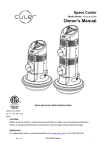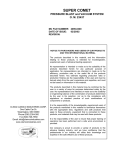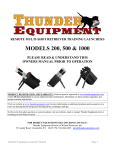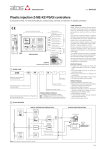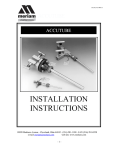Download 35B - Evo X Service Manuals
Transcript
35B-1 GROUP 35B FOUR-WHEEL ANTI-LOCK BRAKE SYSTEM (4ABS) CONTENTS GENERAL DESCRIPTION. . . . . . . . . CONSTRUCTION DESCRIPTION . . . SENSOR . . . . . . . . . . . . . . . . . . . . . . . . . . . 35B-2 35B-5 35B-5 ACTUATORS . . . . . . . . . . . . . . . . . . . . . . . 35B-6 ASC-ECU . . . . . . . . . . . . . . . . . . . . . . . . . . 35B-7 SYSTEM OPERATION . . . . . . . . . . . . 35B-9 35B-2 FOUR-WHEEL ANTI-LOCK BRAKE SYSTEM (4ABS) GENERAL DESCRIPTION GENERAL DESCRIPTION . The ABS (with EBD and brake assist) that ensures directional stability and controllability during hard braking has been equipped as a standard. This ABS employs a 4-sensor system that independently controls the right and left wheels of front and rear, and has the following features: • Compared with the conventional model, by adding the information from the G and yaw rate sensor, master cylinder pressure sensor, and wheel cylinder pressure sensor to the ABS control, the braking performance and steering performance when driving in high speed and on race circuits have been improved so that the vehicle's high athletic performance can be further demonstrated. M2351000101059 *1 • EBD (Electronic Brake-force Distribution system) control that can provide ideal rear wheel brake force has been employed. • The magnetic encoder for wheel speed detection has been installed instead of the rotor as the wheel speed sensor. • For wiring harness saving and secure data communication, CAN *2 bus has been adopted as a tool of communication with another ECU. NOTE: . • *1: EBD (Electronic Brake-force Distribution) • *2: For more details on CAN (Controller Area Network), refer to GROUP 54C P.54C-2. • As with the active skid control (ASC), ABS is controlled by ASC-ECU. . SPECIFICATIONS Item Specifications ABS control type 4 sensors Wheel speed sensor Magnetic encoder Type . TSB Revision Front 96 (N pole: 48, S pole: 48) Rear 86 (N pole: 43, S pole: 43) Semiconductor 35B-3 FOUR-WHEEL ANTI-LOCK BRAKE SYSTEM (4ABS) GENERAL DESCRIPTION CONSTRUCTION DIAGRAM 9 11 10 12 SERVICE REQUIRED 6, 7, 8, 14 CHECK 5 4 3 13 1 2 1 2 AC708736 AB TSB Revision 35B-4 FOUR-WHEEL ANTI-LOCK BRAKE SYSTEM (4ABS) GENERAL DESCRIPTION MAIN COMPONENTS AND FUNCTIONS Parts name Sensor No. Functional description Wheel speed sensor 1 Outputs the frequency pulse signal in proportion to the rotation speed of each wheel to ASC-ECU. Magnetic encoder for wheel speed detection 2 When the magnetic encoder for wheel speed detection (a plate on which north and south pole sides of the magnets are arranged alternately) rotates, the wheel speed sensor outputs frequency pulse signal in proportion to each wheel speed. Stop light switch 3 Outputs the signal indicating whether the brake pedal is depressed or not to ASC-ECU. G and yaw rate sensor 4 Detects the yaw rate and longitudinal/lateral acceleration of a vehicle, then outputs the signal to ASC-ECU via the CAN line. Steering wheel sensor 5 Detects the steering angle of steering wheel, and outputs the signal to ASC-ECU via the CAN bus line. Master cylinder pressure 6 sensor Integrated into the hydraulic unit, converts the signal of brake fluid pressure in master cylinder to the voltage value, then outputs the value to ASC-ECU. Wheel cylinder pressure 7 sensor Integrated into the hydraulic unit, converts the signal of brake fluid pressure in wheel cylinder of each wheel to the voltage value, then outputs the value to ASC-ECU. Hydraulic unit 8 Drives the solenoid valve using the signal from ASC-ECU, and controls the brake fluid pressure for each wheel. ABS warning light 9 Informs the driver of the system status by illuminating, flashing, or turning off the warning light according to the signal from ASC-ECU. ABS warning display 10 Informs the driver of the system status by illuminating or turning off the warning light according to the signal from ASC-ECU. Brake warning light 11 Used as the warning light for the parking brake, brake fluid level, and EBD control. Informs the driver of the system status by illuminating or turning off the warning light according to the signal from ASC-ECU. Brake warning display 12 Used as the warning light for the brake fluid level and EBD control. Informs the driver of the system status by illuminating or turning off the warning light according to the signal from ASC-ECU. Data link connector 13 Outputs the diagnostic trouble code and establishes the communication with the scan tool. ASC control unit (ASC-ECU) 14 Controls the actuators (described above) based on the signals coming from each sensor. Actuator Controls the self-diagnostic functions and fail-safe functions. Controls diagnostic function (Compatible with scan tool). . TSB Revision FOUR-WHEEL ANTI-LOCK BRAKE SYSTEM (4ABS) CONSTRUCTION DESCRIPTION 35B-5 SYSTEM CONFIGURATION Refer to GROUP 35C − General Description P.35C-2. . ABS ELECTRICAL DIAGRAM Refer to GROUP 35C − General Description P.35C-2. CONSTRUCTION DESCRIPTION SENSOR M2351001000687 WHEEL SPEED SENSOR FRONT REAR Rear wheel speed sensor Front wheel speed sensor Encoder for wheel speed detection Encoder for wheel speed detection AC507376AB The wheel speed detecting section is a kind of a pulse generator. It consists of the magnetic encoder for wheel speed detection (plate on which north and south pole sides of the magnets are arranged alternately) which rotates at the same speed of the wheel and the wheel speed sensor (semiconductor sensor). This sensor outputs frequency pulse signals in proportion to the wheel speed. The front wheel speed detecting section consists of the front wheel speed sensor mounted on the knuckle and the magnetic encoder for wheel speed detection which is press-fitted together with the oil seal to the front wheel bearing. The rear wheel speed detecting section consists of the rear wheel speed sensor mounted on the knuckle assembly and the magnetic encoder for wheel speed detection which is press-fitted together with the oil seal to the rear wheel bearing. G AND YAW RATE SENSOR This sensor is installed under the instrument panel center lower, and detects the yaw rate as well as the lateral and longitudinal acceleration of the vehicle. SRS-ECU G&yaw rate sensor AC613534AB TSB Revision 35B-6 FOUR-WHEEL ANTI-LOCK BRAKE SYSTEM (4ABS) CONSTRUCTION DESCRIPTION STEERING WHEEL SENSOR The steering wheel sensor is mounted to the column switch, and detects the rotational angle of the steering wheel. Steering wheel sensor AC709400AB ACTUATORS M2351002000475 . HYDRAULIC UNIT As with the active skid control (ASC), ABS is controlled by ASC-ECU. NOTE: For more information on the internal hydraulic circuit of hydraulic unit, refer to GROUP 35C − System Operation P.35C-14. . ABS WARNING LIGHT, ABS WARNING DISPLAY, BRAKE WARNING LIGHT, BRAKE WARNING DISPLAY The ABS system illuminates or flashes the ABS warning light, ABS warning display, brake warning light, or brake warning display under the following conditions, and informs the driver of the ABS system status. ABS warning light, ABS warning display, brake warning light and brake warning display illumination or flashing pattern State ABS warning ABS warning Brake warning Brake warning light display light display Normal Correct − − − − Faulty ABS failure Illuminates Illuminates − − EBD failure Illuminates Illuminates Illuminates Illuminates Actuator not operated − − − − Actuator operated Flash (2Hz) − − − After actuator operated* Illuminates* − Illuminates* − When scan tool is connected NOTE: . • *: The ABS warning light and brake warning light remain illuminated until the ignition switch is turned to the LOCK (OFF) position. TSB Revision • When the brake fluid level in the brake fluid reservoir tank is at a specified value or less, or when the parking brake lever is in the operating status, the brake warning light illuminates. 35B-7 FOUR-WHEEL ANTI-LOCK BRAKE SYSTEM (4ABS) CONSTRUCTION DESCRIPTION ASC-ECU • This ECU incorporates the ABS function, EBD function, ASC function, and TCL function. • By integrating ABS-ECU into the hydraulic unit, no more wiring harnesses for sending signal that operates the solenoid valve and pump motor is required, assuring higher reliability. • Self-diagnostic and memory functions are integrated into ASC-ECU. If any malfunction is detected by the diagnostic function, ABS-ECU activates a fail-safe function and illuminates the ABS warning light and brake warning light*. NOTE: *: The brake warning light is used as the EBD control warning light. M2351003000713 • ASC-ECU detects the vehicle deceleration speed using the signals of the steering wheel sensor, wheel speed sensor, G and yaw rate sensor, master cylinder pressure sensor, and wheel cylinder pressure sensor to acquire the wheel rotation status. At the same time, ASC-ECU estimates the wheel slipping status based on the preprogrammed algorithm, and then controls the solenoid valve in the hydraulic unit so that the wheels do not lock. ABS HYDRAULIC PRESSURE CONTROL . ABS CONTROL CYCLE Increase Hold Decrease Wheel speed Estimated vehicle speed C A D B Actual vehicle speed Brake pressure a e d b c AC506830AB 1. ASC-ECU calculates the speed and deceleration of each wheel based on the signals from the wheel speed sensors and G and yaw rate sensors of four wheels, and estimates the vehicle speed of at that time. TSB Revision 35B-8 FOUR-WHEEL ANTI-LOCK BRAKE SYSTEM (4ABS) CONSTRUCTION DESCRIPTION 2. When the brake is depressed, the brake fluid pressure applied to the wheel cylinder increases, and the wheel speed decreases. When the difference between the wheel speed and vehicle speed increases, and the vehicle deceleration exceeds the specified value (Point A), ASC-ECU determines that the wheels are about to be locked. At this time, ASC-ECU reduces the brake fluid pressure by outputting the pressure decrease signal to the solenoid valves (IN, OUT). (Between a and b) 3. When the vehicle deceleration and wheel speed begin to recover, and when the vehicle speed reaches the point B, ASC-ECU outputs the pressure hold signal to maintain the wheel cylinder fluid pressure. (Between b and c) 4. When the wheel speed deceleration recovers further and passes the point C, ASC-ECU determines that the wheel lock possibility has been eliminated, and maintains the brake fluid pressure by outputting the pressure increase signal again. (Between c and d) 5. Brake fluid pressure is controlled through the repetition of pressure increase and pressure hold. (Between d and e) 6. When the wheel deceleration exceeds the threshold again, ABS-ECU controls the brake fluid pressure by repeating the cycle (Steps 2 to 5). . EBD FLUID PRESSURE CONTROL EBD operating conceptual design Braking force distribution by EBD control Ideal distribution curve when seated by fixed persons Rear braking force Braking force distribution curve by the existing proportioning valve Ideal distribution curve when seated by one persons Braking Force Improved Front braking force AC208548AB EBD control is activated within the lower slip ratio area where ABS is disabled. EBD calculates the vehicle deceleration and slip amount of the four wheels based on the wheel speed sensor signal. If the rear wheel speed differs from the vehicle speed by a certain level or more, EBD boosts, holds, and depressurizes the rear wheel control solenoid valve in the hydraulic unit, and then adjusts the rear wheel brake fluid pressure fairly close to an ideal distribution curve. . TSB Revision FOUR-WHEEL ANTI-LOCK BRAKE SYSTEM (4ABS) SYSTEM OPERATION 35B-9 INITIAL CHECK CONSTANT CHECK ASC-ECU performs the following initial checks using the diagnostic functions. The ABS warning light illuminates for approximately 3 seconds (including the initial check)* after the ignition switch is turned ON. If any malfunction is detected, ABS-ECU continues illuminating the ABS warning light and disables the ABS control. NOTE: *: ABS warning light may keep illuminating after the ignition switch is turned ON until the startup vehicle speed reaches approximately 10 km/h. This allows, as long as ASC-ECU retains any diagnostic trouble code, which is related to the wheel speed sensor malfunction or pump motor malfunction recorded during the previous ignition ON status, ASC-ECU to continue illuminating the ABS warning light until it verifies that the malfunction for that code is resolved (startup check). ASC-ECU constantly checks the following items. 1. ASC-ECU (1) Performs a self-diagnosis of ASC-ECU. (2) Checks for abnormal output voltage of G and yaw rate sensor, and detects an open or short circuit in the G and yaw rate sensor. (3) Checks the output voltage for G and yaw rate sensor, and determines that a seizure has occurred to the G sensor when the output voltage exceeding the specified level continues for a certain period or more. 2. ECU power supply . STARTUP CHECK When the startup vehicle speed reaches approximately 10 km/h, ASC-ECU performs the following checks. 1. Motor, solenoid valve check (Initial startup* only) Turns ON the motor relay in ECU, and checks the pump motor operation. At the same time, ASC-ECU sequentially energizes each solenoid valve for a very short period, and checks the valve operation. NOTE: *: Initial startup indicates the first startup after the system has started. 2. Wheel speed sensor check Checks if ECU power supply voltage is within the operational range. 3. Wheel speed sensor (1) Monitors the output current of the sensor signal wiring harness, and checks for an abnormal output current (open/short circuit). (2) Checks if there is any wheel that does not send pulse signal while the vehicle is in motion. (3) Checks for an input of abnormally higher or lower wheel speed in relation to the vehicle speed. 4. Pump motor, solenoid valve Checks that the ASC-ECU output signal and the operating statuses of pump motor and solenoid valve agree with each other. ABS-ECU checks if the wheel speed sensor signal is received from all the wheel speed sensors. . FAIL-SAFE AND DIAGNOSTIC FUNCTION If any malfunction is detected by the diagnostic function, ASC-ECU illuminates the ABS warning light and brake warning light, and disables the ABS and EBD controls. In this case, the brake is operated as a normal brake. Also, ASC-ECU has the following functions for easier system checks. • Diagnostic trouble code set • Service data output • Actuator test SYSTEM OPERATION Refer to GROUP 35C − System Operation P.35C-14. TSB Revision M2351004000374 NOTES











